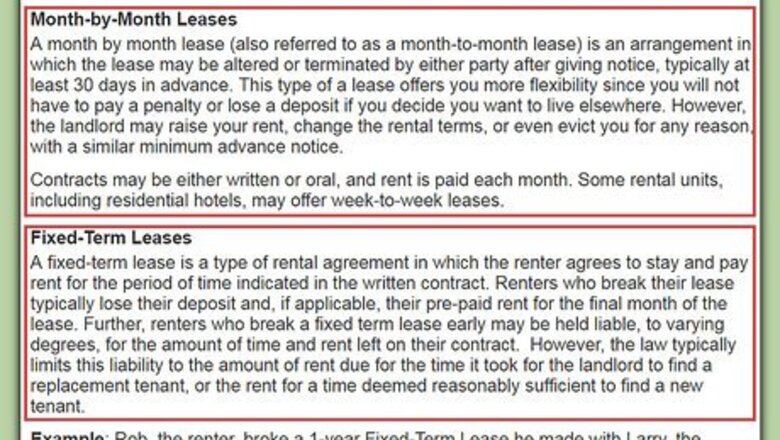
views
- Address your letter to your landlord, date it, and state the purpose of the letter. For example, you might say, “I am writing to notify you of my intent to terminate the lease agreement.”
- In the body of your letter, ask for any refundable deposits to be returned to you, and provide the landlord with your new address. Finish by signing your legal name.
- Make a copy of your letter and check your contract’s delivery clause. Your clause should specify the location to which your letter must be mailed or hand-delivered.
Understanding Your Lease Agreement

Know what type of tenancy you have. In order to provide adequate notice to terminate your lease agreement, you will need to know what type of tenancy you and the landlord have entered into. For residential rental agreements, the most common type of tenancy is a periodic tenancy. Periodic tenancies can come in many forms, but two of the most common forms include: Month-to-month tenancies. A month-to-month tenancy is an arrangement in which the lease may be altered or terminated monthly upon proper notice. This type of lease offers a great deal of flexibility because of your ability to terminate the lease once every month. However, the landlord also holds a good level of flexibility and may be able to raise rent or change rental terms with the same minimal notice. Fixed term leases. Fixed term leases are rental agreements in which you agree to stay and pay rent for a fixed period of time, most often one year. In this situation, a renter who breaks their lease early may incur penalties for not staying for the agreed upon period.
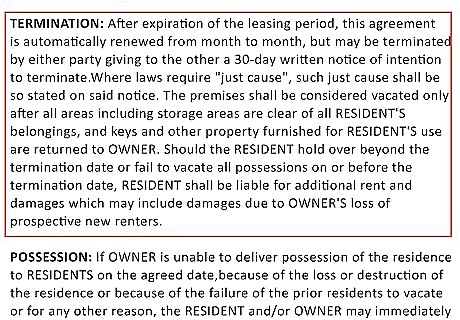
Read the termination clause in your lease. Your rental agreement may or may not include a termination clause. If it does, be sure to read and understand it because in most situations this will provide you with directions on how to terminate your lease. If your rental agreement clearly sets forth the manner in which you should provide your landlord with notice, then follow those directions. For example, a lease agreement may state, "Tenant shall provide landlord with at least 10 days notice prior to vacating the premises." In this situation, you should provide your landlord with notice at least 10 days before you move out. If your rental agreement is silent regarding termination, you should follow your state's laws. For example, in Oregon, a month-to-month tenancy can be terminated by giving the landlord written notice not less than 30 days prior to the date you plan to move out. If you have a fixed term lease of at least one year in Oregon, you can terminate the lease by providing not less than 30 days notice prior to the agreed upon end date of the fixed term, or not less than 30 days prior to the date you designate in your notice letter, whichever is later. As you can see, in Oregon, at least 30 days notice is required. If you are in a month-to-month tenancy, you can terminate your lease at any time so long as you provide 30 days notice. However, if you are in a fixed term lease, you will not be able to terminate until the fixed term is up (unless you are willing to incur some penalty).
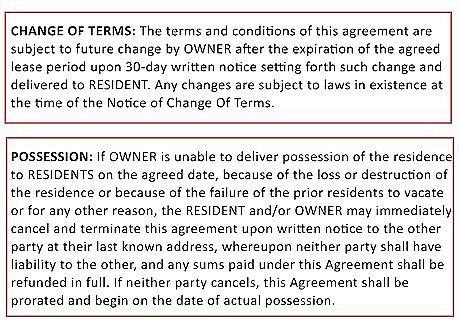
Look for a delivery clause in your lease. In addition to understanding how much notice you need to provide your landlord, you also need to understand how that notice needs to be delivered. If your rental agreement sets out the manner in which you must deliver the notice, then you must follow that language. If your lease agreement is silent, then you should follow your state's law. For example, your rental agreement may state, "Any notice must be provided in writing and delivered in person and through first class mail to the address provided in this Agreement." Under this clause, you would be required to write your notice (i.e., not provide notice verbally) and deliver that written notice both in person to the landlord and through the mail. If there is no delivery clause, your state statutes will set forth the manner in which delivery must take place. In Oregon, you can choose to deliver your written notice either in person to the landlord or through the mail to the landlord. If you provide notice through the mail, the minimum notice requirement (e.g., 30 days) will be extended by three days. Therefore, in Oregon, if you deliver your 30 day notice through the mail, you will actually have to provide the landlord 33 days notice in order to account for the delivery time.
Writing Your Notice Letter

Address the letter to your landlord. When you write your termination notice to your landlord, you need to address the letter properly. In order to do so, look at your lease agreement and find the landlord's official address. If it is not provided, call your landlord and ask how the letter needs to be addressed. If you cannot get a hold of your landlord, use the address you have for paying rent. In most states, including California, a rental agreement is required to include an address where notices can be addressed to.

Date your notice letter. Either before or after the landlord's address, you will include the date your notice is delivered. This ensures your landlord understands when your notice period will start. For example, if you are required to provide 30 days notice in order to terminate your lease, and you date your notice August 1, 2013, which is when you personally delivered the notice to your landlord, you and your landlord will understand that the 30 day period starts on August 1, 2013.
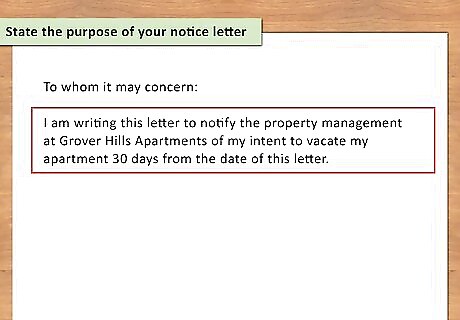
State the purpose of your notice letter. The first body paragraph of your notice letter should state the reason you are writing the letter. This gives the landlord an idea of how they need to respond, if they need to respond at all. You can write something as simple as, "I, John Smith, live at [address]. I am writing to notify you of my intent to terminate the lease agreement between myself and you. I am providing the required 30 days notice, which will start from the day this letter is dated." In most states, you do not need to state any specific reason for your intent to terminate. It is sufficient to simply state that you are terminating your tenancy as required by law.
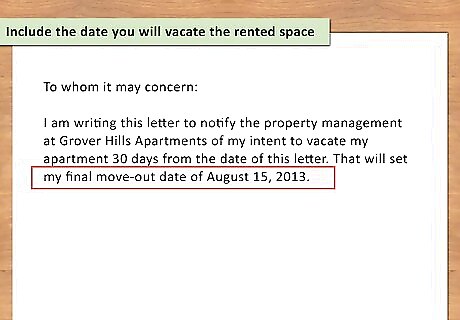
Include the date you will vacate the rented space. In addition to the date of delivery, the body of your letter should also state the date in which you will vacate the premises. This date will need to be some time after the required notice period is up. For example, if you are required to provide 30 days notice and you delivered it on August 1, 2013, the date you will vacate will have to be August 30, 2013 or after. While you can certainly move out before the 30 days are up, you will be responsible for the rental unit, including rent payments, until the 30 days are up and you have vacated.
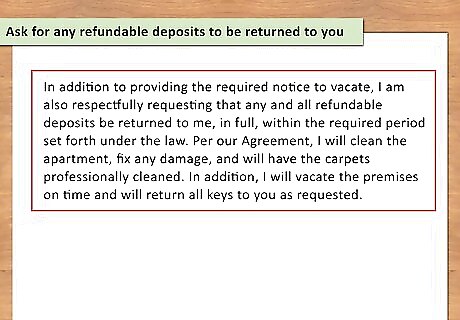
Ask for any refundable deposits to be returned to you. In another body paragraph, you should respectfully request that any refundable deposits (e.g., security deposit) be returned to you upon satisfactorily vacating the premises. In addition to requesting any deposits be returned to you, you should state all of the reasons you have complied with the lease agreement, and therefore why you deserve the deposits back. For example, your security deposit is often returned to you so long as you vacate the premises on time and so long as you clean the premises as required before you vacate. If this is the case in your lease agreement, state that you plan on leaving on time and that you will clean the premises in a satisfactory manner. Your request may look something like this: "In addition to providing the required notice to vacate, I am also respectfully requesting that any and all refundable deposits be returned to me, in full, within the required period set forth under the law. Per our Agreement, I will clean the apartment, fix any damage, and will have the carpets professionally cleaned. In addition, I will vacate the premises on time and will return all keys to you as requested."
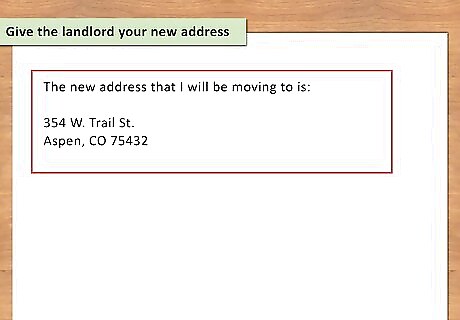
Give the landlord your new address. Before you end the letter, be sure to give the landlord your new address. This new address is where your refundable deposit will be sent, as well as any notifications you may need to receive after you vacate the premises.
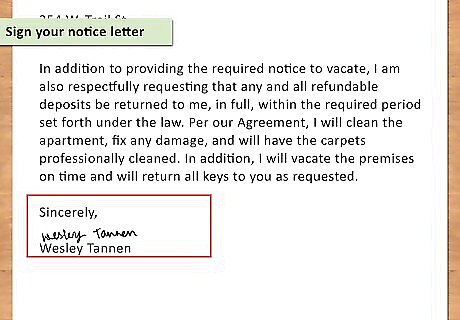
Sign your notice letter. Once you have written the entire notice letter, you will want to sign it. This will make it official and help if there is some dispute between you and your landlord about the notice.

Make a copy of your notice letter. Once you have written the notice letter, make a couple of copies for yourself. If your landlord doesn't receive the notice, or there is some dispute about the notice, you will want a copy you can look back on.
Delivering Your Notice Letter
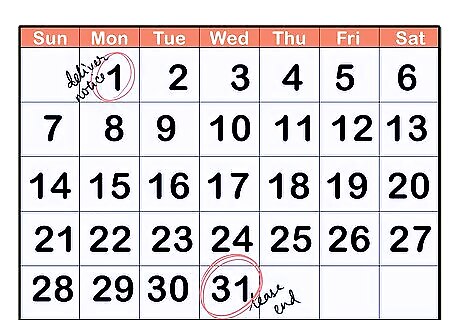
Choose when you want to deliver your notice letter to your landlord. After completing your termination notice letter, you will want to consider when to give it to your landlord. Remember, the notice period will not start until your notice is delivered to your landlord. If you are in a month-to-month tenancy, you should deliver your notice letter along with your last month's rent. This will ensure that you provide the required 30 days notice and that you will have paid the last month's rent. If you have a fixed term tenancy, you should deliver the notice 30 days (or however long your state's notice requirement is) before the term is up. For example, if you signed a lease that ends on August 31, 2013, you should deliver your notice August 1, 2013. While you can give the landlord notice at any time during the rental period, if you give notice in the middle of the month you will be required to cover part of the next month's rent. For example, assume you have a month-to-month tenancy and you pay rent on the first of the month. You could give your notice on the tenth of the month but you would be required to pay rent through the tenth of the following month.

Deliver the notice letter to your landlord properly. After deciding when you want to deliver your notice, remember to look at your lease agreement or your state's laws and understand how you will have to deliver your notice. Make sure you follow the correct procedures to ensure your notice is valid.
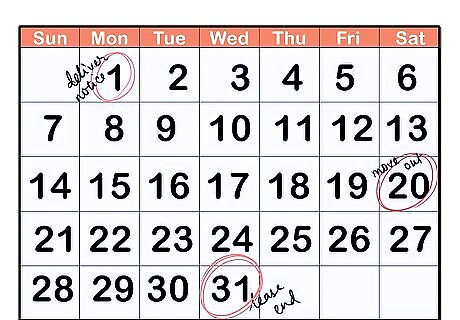
Move out by the required date. Once you have delivered your notice, be sure you vacate the property on or before the date you specified in your notice letter.



















Comments
0 comment